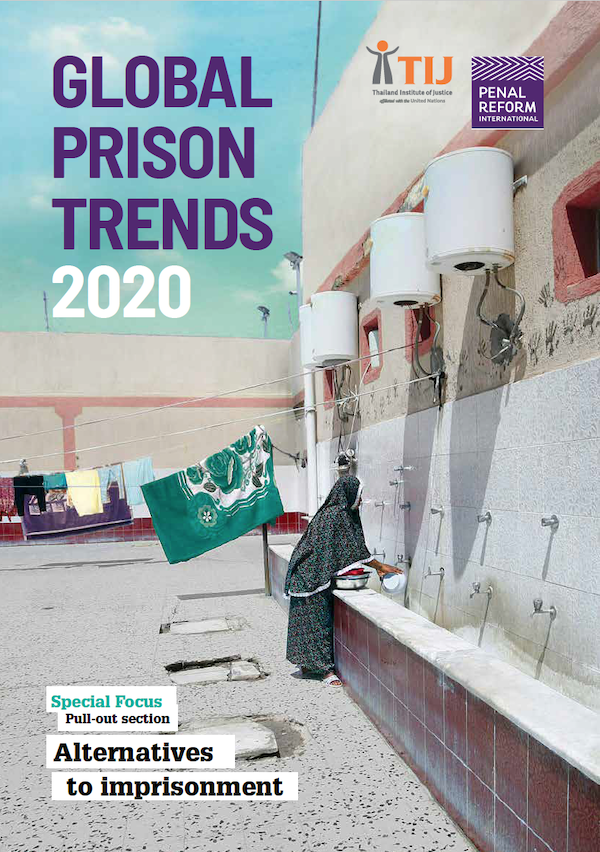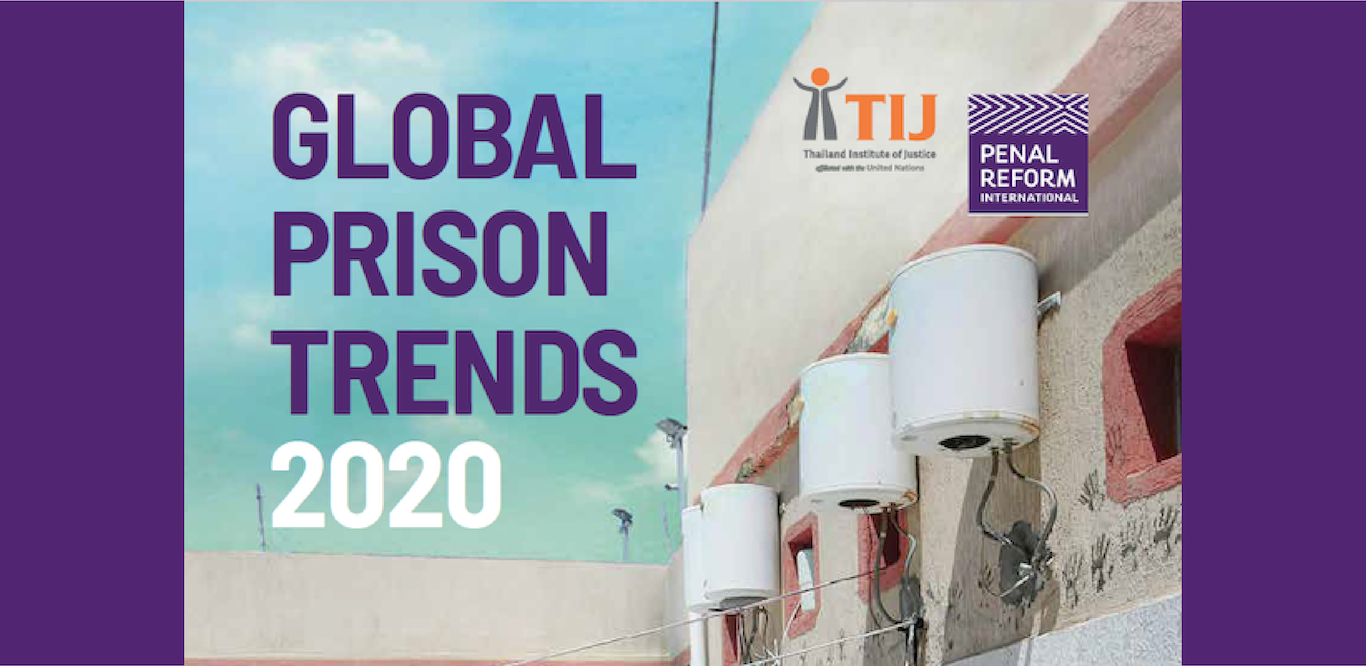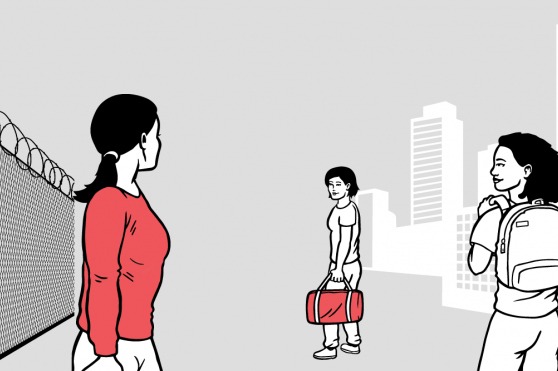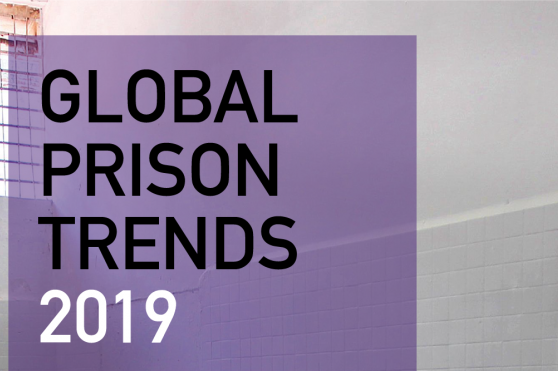Global Prison Trend Report
Increased Overcrowding – Risk of Epidemic
Policy Adjustment and Long-term Alternative Measures Recommended
Summary of Important Statistics
- At present, the prison population is at 11 million prisoners globally. Three million of which are prisoners on remand.
- Over 50 per cent of the prisoners are imprisoned for non-violent crimes.
- There is a 50 per cent increase of female prisoners since the year 2000, and over 19,000 children are living with their mothers in prison.
- With a heavier focus on prison sentences and lack of non-custodial measures, prisons in 124 countries reported overcrowding problems.
While social distancing measures are being implemented all over the world to prevent the spread of Coronavirus disease or COVID-19, the implementation of such measures proves to be difficult inside prisons, according to the Global Prison Trends 2020. With over 11 million prisoners globally and prisons in at least 124 countries accommodating prisoners over their standard capacities, the absence of effective criminal justice and prison management policies can lead to even more devastating outcome in the near future.
The Global Prison Trends 2020 is an annual report developed by Thailand Institute of Justice (TIJ) together with Penal Reform International to present the overview of prison management and exercise of custodial sentences globally. The sixth edition of this Report was published amidst the COVID-19 pandemic that is threatening the health of the global citizens, especially prisons which are considered as large-scale, high-risk area.
Numbers of Prisoners Worldwide - Significant and Continuously Increasing
Global Prison Trends 2020 highlights an interesting statistic whereby more than 3 million prisoners (from over 11 million globally) are those who have not yet been convicted by the court. Moreover, it found that, in at least 46 countries, the numbers of prisoners on remand are higher than those whose judgments are final. This reflects the gap in the practical implementation of "Innocent until Proven Guilty" principle.
When considering the types of crime, it found that more than 50 per cent of the prisoners were offenders of non-violent crimes. There is only 7 per cent of the prisoners who were convicted of a serious offence such as murder. The figures illustrate that judicial processes globally tend to use prisons as the main instrument to detain the alleged or imprison the convicts and there continues to be a lack of other penalization measures that are proportionate to the nature of the crimes.
Furthermore, policies on narcotics which focus on custodial sentences to suppress narcotic offenses remain one of the main factors of high incarcerations, particularly those with low income from impoverished communities. More than 2 million prisoners or over 20 per cent of the global prison population are convicts of narcotic offenses. 83 per cent of which were charged with using or having in possession illegal drugs. However, with the statistic indicating 30 per cent increase of global drug users since 2009, this reflects that enforcing severe penalization measures do not solve narcotic problems and cannot indeed suppress the crimes committed by drug cartels in narcotic manufacturing and mobilization.
Female Prisoners
The Report indicates that there is an increase of female prisoners by 50 per cent from the year 2000 with the current number being 700,000 prisoners and there are multiple economic and societal factors that affect the figures mentioned above. When more women are convicted with custodial sentences, it will inevitably affect children under their care. It is estimated that as many as 19,000 children globally living in prisons with their mothers.
Moreover, the population of female prisoners convicted with narcotic offenses (35 per cent) is higher than the male prisoners (19 per cent) of the same crimes. In Thailand, specifically, female prisoners who are offenders of these crimes are as high as 84 per cent (comparing to 78.9 per cent of male prisoners). The figure reflects the adverse effect which narcotics policies imposed upon women. According to the study conducted by TIJ, it found that burden from family care, being victims of violence and abuse, being benighted or deceived are the root causes of the high number of female offenders in narcotic crimes.
Budget and Public Health Restrictions
Prison overcrowding issue has been causing many challenges to prison management such as shortages of staff, resources and budget, sub-standard sanitary and hygiene as well as the effectiveness of prisoner rehabilitation. This report indicates that the proportion of the annual budget being allocated to prisons globally is infinitesimal or equivalent to only 0.3 per cent of a country's GDP (based on information from 54 countries). This budget is usually spent on renovation, staff compensation and for prison security while the inmate food budget is meager in many countries such as in Kazakhstan, Cambodia, and the Central Africa Republic in which only 1 euro is allocated as food budget per one prisoner per day.
Restrictions on public health and health care services are also another vital challenge for prisons globally. There are indications of severe shortages of medical personnel in some countries such as in Bangladesh where there are only ten doctors treating prisoners in 68 prisons and only two doctors treating 15,000 prisoners country-wide in Ghana.
COVID-19 and Impact on Prisons
In light of COVID-19 pandemic situation, the World Health Organization provided that prisons are the area at risk of the spread of Coronavirus since the majority of the prisoners have low financial status, unable to access health care services and have an existing health condition before being incarcerated. Additionally, overcrowding and shortage of resources in prisons can lead to unhygienic conditions. At present, confirmed cases of COVID-19 and fatalities among prisoners were found in many countries. Moreover, concerns relating to the spread of COVID-19 also led to unrests and losses in many prisons worldwide. TIJ developed "Report on Situation and Policy Recommendations on the Spread of Coronavirus (COVID-19) in Prisons" to give an overview of the challenges encountered by prisons globally. A section of this report proposes that Thailand implement measures other than imprisonment for certain groups of prisoners such as prisoners on remand, convicted prisoners with less than one remaining year of imprisonment, older prisoners and prisoners convicted of petty offenses.
Alternatives to Imprisonment
Global Prison Trends 2020 contained a Special Focus section on the issue of "Alternatives to Imprisonment" which corresponds to United Nations Standard Minimum Rules on Non-custodial Measures (the Tokyo Rules). It recommended that such alternative measures are implemented as a main instrument in reducing the number of detainees in prisons and solving the issue of prison overcrowding in the long run.
Examples of countries in Scandinavia such as Finland, Norway, Denmark and Sweden present the success in implementing alternatives to imprisonment. The governments of these countries have been able to maintain the numbers of prisoners at the level lower or equal to the standard capacity of their respective prisons. Alternatives to imprisonment have been implemented for the alleged persons on remand such as bailing or reducing the cap on bail guarantee, using electronic tracking devices, enforcing travel ban, or prohibiting leaving an accommodation. The non-custodial measures implementation is also to respect the human rights of the people who are still deemed innocent and also to prevent the imprisonment of any person who is not yet convicted.
Apart from reducing prison overcrowding issue, alternatives to imprisonment also allow these offenders to make up for their crime in ways that can benefit society. They would not have to be parted with their families, can still generate income from working and overall reduce the exploitation of resources and budget in the judicial processes.
However, the report points out the absence of supportive legislations, policies on severe criminal punishment to increase credibility and enhance the image of the government and prejudice from policymakers continue to hinder the success of implementing alternative measures in criminal justice procedures all over the world.
Hence, this report emphasizes that in order to sustainably encourage alternatives to imprisonment as the "principle penalization measures" instead of being just an alternative, it requires both internal changes in the criminal justice process and consideration on the social structure that oppresses people in all marginalized groups. This will lead to the design of the mechanism that offers justice to the people who is unable to access it.
The full English version of Global Prison Trends 2020, click here








